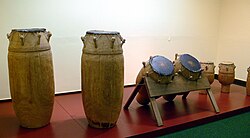
U2 are an Irish rock band formed in Dublin in 1976. The group comprises Bono, the Edge, Adam Clayton, and Larry Mullen Jr.. Initially rooted in post-punk, U2's musical style has evolved throughout their career, yet has maintained an anthemic quality built on Bono's expressive vocals and the Edge's chiming, effects-based guitar sounds. Bono's lyrics, often embellished with spiritual imagery, focus on personal and sociopolitical themes. Popular for their live performances, the group have staged several elaborate tours over their career.

The xylophone is a musical instrument in the percussion family that consists of wooden bars struck by mallets. Like the glockenspiel, the xylophone essentially consists of a set of tuned wooden keys arranged in the fashion of the keyboard of a piano. Each bar is an idiophone tuned to a pitch of a musical scale, whether pentatonic or heptatonic in the case of many African and Asian instruments, diatonic in many western children's instruments, or chromatic for orchestral use.
There are many styles of traditional and modern music of Ghana, due to Ghana's worldwide geographic position on the African continent.

The music of Nigeria includes many kinds of folk and popular music. Little of the country's music history prior to European contact has been preserved, although bronze carvings dating back to the 16th and 17th centuries have been found depicting musicians and their instruments. The country's most internationally renowned genres are Indigenous, Apala, Aurrebbe music, Rara music, Were music, Ogene, Fuji, Jùjú, Afrobeat, Afrobeats, Igbo highlife, Afro-juju, Waka, Igbo rap, Gospel,Nigerian pop and Yo-pop. Styles of folk music are related to the over 250 ethnic groups in the country, each with their own techniques, instruments, and songs. The largest ethnic groups are the Igbo, Hausa and Yoruba. Traditional music from Nigeria and throughout Africa is often functional; in other words, it is performed to mark a ritual such as the wedding or funeral and not to achieve artistic goals. Although some Nigerians, especially children and the elderly, play instruments for their own amusement, solo performance is otherwise rare. Music is closely linked to agriculture, and there are restrictions on, for example, which instruments can be played during different parts of the planting season.
The music of Sri Lanka has its roots in five primary influences: ancient folk rituals, Hindu religious traditions, Buddhist religious traditions, the legacy of European colonisation, and the commercial and historical influence of nearby Indian culture—specifically, Kollywood cinema and Bollywood cinema.
Gagaku is a type of Japanese classical music that was historically used for imperial court music and dances. Gagaku was developed as court music of the Kyoto Imperial Palace, and its near-current form was established in the Heian period (794–1185) around the 10th century. Today, it is performed by the Board of Ceremonies in the Tokyo Imperial Palace.

The music of Myanmar shares many similarities with other musical styles in the region. Traditional music is melodic, having its own unique form of harmony, often composed with a 4
4 (na-yi-se), a 2
4 (wa-let-se) or a 8
16 time signature. In Burmese, music segments are combined into patterns, and then into verses, making it a multi-level hierarchical system. Various levels are manipulated to create a song. Harmony in Mahagita is known as twe-lone, which is similar to a chord in western music. For example, C is combined with F or G.

The music of West Africa has a significant history, and its varied sounds reflect the wide range of influences from the area's regions and historical periods.
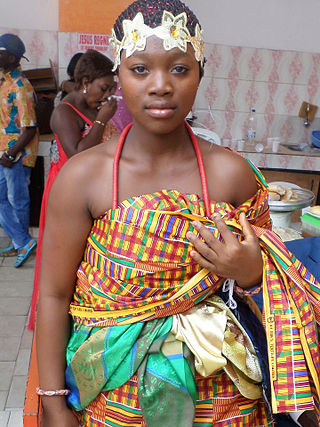
The Bono, also called the Brong and the Abron, are an Akan people of West Africa. Bonos are normally tagged Akan piesie or Akandifo of which Akan is a derivative name. Bono is the genesis and cradle of Akans. Bono is one of the largest ethnic group of Akan and are matrilineal people. Bono people speak the Bono Twi of Akan language. Twi language, thus the dialect of Bono is a derivative of a Bono King Nana Twi. In the late fifteenth century, the Bono people founded the Gyaaman kingdom as extension of Bono state in what is now Ghana and Côte d'Ivoire.
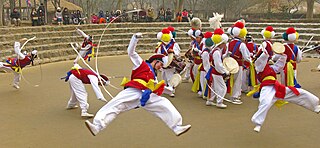
Pungmul is a Korean folk music tradition that includes drumming, dancing, and singing. Most performances are outside, with dozens of players all in constant motion. Pungmul is rooted in the dure farming culture. It was originally played as part of farm work, on rural holidays, at other village community-building events, and to accompany shamanistic rituals, mask dance dramas, and other types of performance. During the late 1960s and 1970s it expanded in meaning and was actively used in political protest during the pro-democracy movement, although today it is most often seen as a performing art. Based on 1980s research, this kind of music was extensively studied in Chindo Island.

The talking drum is an hourglass-shaped drum from West Africa, whose pitch can be regulated to mimic the tone and prosody of human speech. It has two drumheads connected by leather tension cords, which allow the player to change the pitch of the drum by scraping the cords between their arm and body.

The janggu or seyogo is a drum often used in traditional Korean music. It consists of an hourglass-shaped body with two heads made from various types of leather. The two heads produce sounds of different pitch and timbre, which when played together are believed to represent the harmonious joining of Um and Yang. The janggu is one of the four components of samul nori (사물놀이), alongside the buk (북), jing (징) and kkwaenggwari (꽹과리).

The buk (Korean: 북) is a traditional Korean drum. While the term buk is a native Korean word used as a generic term meaning "drum", it is most often used to refer to a shallow barrel-shaped drum, with a round wooden body that is covered on both ends with animal skin. Buk are categorized as hyeokbu which are instruments made with leather, and has been used for jeongak and folk music.

In many parts of sub-Saharan Africa, the use of music is not limited to entertainment: it serves a purpose to the local community and helps in the conduct of daily routines. Traditional African music supplies appropriate music and dance for work and for religious ceremonies of birth, naming, rites of passage, marriage and funerals. The beats and sounds of the drum are used in communication as well as in cultural expression.
Traditional Thai musical instruments are the musical instruments used in the traditional and classical music of Thailand. They comprise a wide range of wind, string, and percussion instruments played by both the Thai majority as well as the nation's ethnic minorities.

Kundu is a pidgin name in Papua New Guinea for an hourglass drum used to accompany formal occasions, religious ceremonies and for celebrations. This drum is emblematic of Papua New Guinea and it appears on the country's coat of arms.

The Atumpan is a type of Asante talking drum. Played in pairs, these drums provide the bass part in Adowa dance ensembles. These drums are also found in Fontomfrom ensembles.
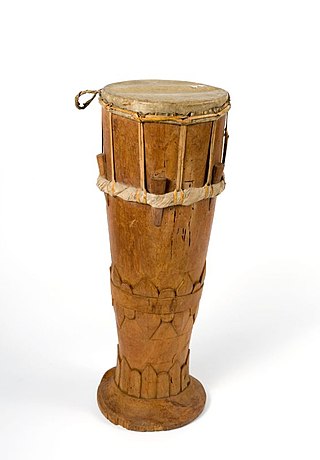
The tifa, tiwa or tiva is a single-headed goblet drum used throughout the Maluku Islands of Eastern Indonesia, where it is traditionally the "dominant instrument" in Maluku province music. The term tifa has been used outside of the Maluku Islands, including on the island of Java and on the island of New Guinea, in Indonesia's Papuan provinces.
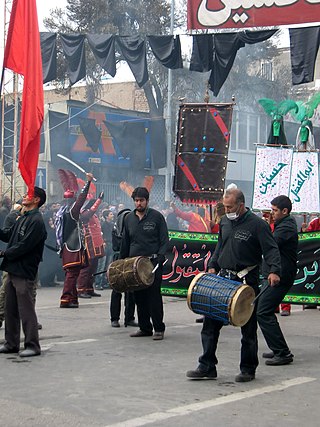
The Dammam is a large double-headed cylinder drum or frame drum played by Shias in Iraq and Iran in religious ceremonies. The dammām is usually struck with the left hand and a curved stick in the right hand, especially during passion plays in the mourning month of Muharram or to wake up the devotees early in the morning of Ramadan.
